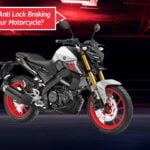Yamaha always keeps updating and providing you with the latest and best riding experience. Yamaha Motors has announced that it has developed a prototype of the EPS (Electric Power Steering) steering support system for motorcycles as a new rider aid contributing to improved motorcycle stability and agility.
The newly developed EPS is a technology falling under the Transforming Mobility focus area of the Company’s Long-Term Vision of ART for Human Possibilities. Yamaha Motor is carrying out development of the system seeing it as a technology not only for transforming mobility for greater fun, safety, and comfort but also as one connected to resolving societal issues in uniquely Yamaha ways.
The EPS steering support system employs sensor technologies that differ from those in power steering systems for automobiles and other four-wheeled vehicles. Utilizing a magnetostrictive torque sensor enables the system to function as a steering damper and provide assisted steering, thereby contributing to a motorcycle’s stability, improving agility, reducing rider fatigue, and more. Yamaha Motor aims to equip EPS on various motorcycles in order to provide a wide range of riders with greater motorcycling fun, safety, and comfort.
The Company plans to use the wealth of data acquired through use in the harsh environment provided by top-level motocross competition to accelerate the system’s development and refinement.
Electric Power Steering (EPS) Main Features
◼ Magnetostrictive torque sensor
The system uses a magnetostrictive torque sensor, which has a proven track record with our electrically power-assisted bicycles, to detect torque. EPS works as
1) a steering damper while providing
2) assisted steering for the rider.
The steering damper feature counteracts the outside forces sent to the handlebars from changes in the road surface and the like and functions primarily at high speeds. The assisted steering complements handlebar inputs in line with the rider’s intentions and mainly functions at low speeds. These two features together achieve assistive intervention that still feels natural for the rider.
◼ Compact and lightweight actuator
Developed a compact and lightweight actuator (device that converts electrical signals into physical movement) for motorcycles with an eye on install
There’s still a direct connection between the bars and forks, so ultimate control is still in the hands of the rider because they say it can tell the difference between inputs at the bars and external influences on the steering – assisting one while counteracting the other.
Yamaha aims to equip EPS on various motorcycles and it wouldn’t be a surprise to find this on Adventure bikes for example where rider aids like cornering sensitive ABS, traction control and active suspension are already common-place. From there it would not be a giant leap to imagine it could work on dual-sport or off-road bikes.
Yamaha says that the initial, motocross version of the setup does most of its assistance at low speeds, when you’re likely to use larger movements of the bars, and as you go faster it turns its focus to its second role as a steering damper. Because it can tell the difference between rider inputs and external forces, the steering actuator can counteract bumps or road surface changes that might try to change the bike’s course. In competition, the result should make the bikes less physical to ride, leaving the rider with more strength and stamina at the end of races. Yamaha says that despite the system, the bikes still feel natural to the riders. Motocross is just the start. It’s clearly compact enough to fit virtually any bike and existing machines wouldn’t need a ground-up redesign to incorporate it. On superbikes, it could easily become a natural next step from the sort of active steering dampers already in use, but for the future, the addition of an electric actuator controlling steering angle opens the door to many other possibilities.




Leave a Reply